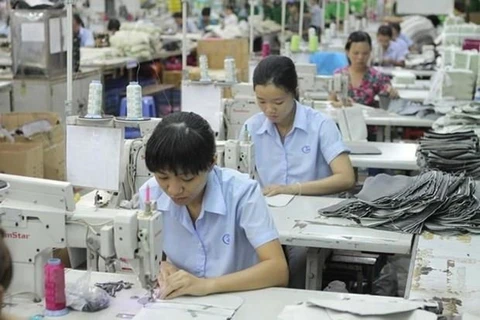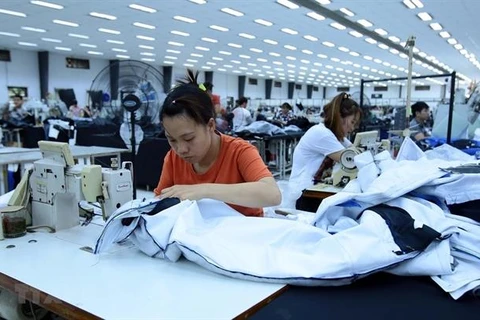Hanoi (VNA) - The number of women at working age in Vietnam reached 22.3 million, accounting for 45.6 percent of the labour force, which is also challenged by the fourth Industrial Revolution.
 The forum attracts representatives from State and National Assembly agencies, organisations and businesses to discuss empowering female workers. (Photo: VietnamPlus)
The forum attracts representatives from State and National Assembly agencies, organisations and businesses to discuss empowering female workers. (Photo: VietnamPlus) Additionally, women are more vulnerable because they do not receive fair treatment in many cases, that’s why their contributions to the society have yet to be adequately and appropriately recognised.
The remarks were made at the Multi-Stakeholder Forum 2019, themed “Empowering women at the workplace in the fourth Industrial Revolution 4.0”, in Hanoi on October 15. The event was co-hosted by the Vietnam General Confederation of Labor (VGCL), the Centre for Studies and Applied Sciences in Gender-Family-Women and Adolescents (CSAGA), and Samsung Vietnam.
Participants discussed opportunities and challenges faced by female workers, Vietnamese enterprises, especially those led by women, during the fourth Industrial Revolution.
VGCL Vice President Ngo Duy Hieu said parties concerned are seeking measures to improve women empowerment.
“Today forum aims to seek solutions via listening to feedback by female workers and parties concerned. We are determined to take practical and timely actions to help female workers overcome challenges and external barriers, as well as those from the fourth Industrial Revolution in particular”, Hieu stressed.
At Samsung Vietnam, female employees account for more than 70 percent. Apart from creating an ideal working environment and developing welfare policies for employees in general, Samsung also attaches importance to providing special care for female workers, especially mothers-to-be and mothers.
General Director of Samsung Vietnam Choi Joo-ho expressed his belief that in the face of profound impacts and great challenges posed to female workers, and with thorough preparations, challenges will turn into opportunities, creating a turning point for them to affirm their position and role in the society.
Vietnam is leading ASEAN in terms of the percentage of working women in total employment, according to a report by the Asian Development Bank (ADB) and the Organisation for Economic Co-operation and Development (OECD).
The share of Vietnamese women in total employment stayed at about 48.5 percent in 2016, however this was little changed from 2009.
Vietnam was closely followed by Laos at 46 percent and Thailand at 45 percent.
The figures were published in the 'Government at a Glance: Southeast Asia 2019' report that was released on September 10.
The report aimed to provide insight into government processes and performance in member countries of the Association of Southeast Asian Nations (ASEAN).
It gathered data in various areas such as public services, promoting digital government and providing better work opportunities for women.
The report showed 48.1 percent of public sector employees in Vietnam in 2016 were women, up from 46 percent in 2009. The latest figure was higher than the average rate of ASEAN at 46.9 percent.
Generally speaking, the report highlighted that women and men were almost equally represented in Southeast Asian public sector employment.
However, the rate plummeted regarding women’s political representation, deemed crucial to ensure women’s perspectives were taken into account in policy-making.
Vietnam ranks third at 27 percent behind the Philippines and Laos in terms of the number of female parliamentarians, higher than the ASEAN average rate of 20 percent and far ahead of Thailand at 5 percent.
A recent survey by ManpowerGroup Vietnam showed that the demand for female workers accounts for 50 percent in office work and garment-textile and electronic sectors. Meanwhile, the rate of Vietnamese women taking the leading role in businesses stands at about 33 percent./.
























